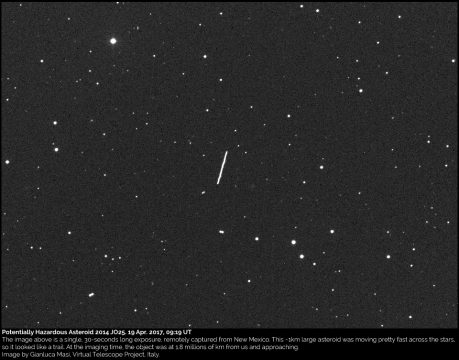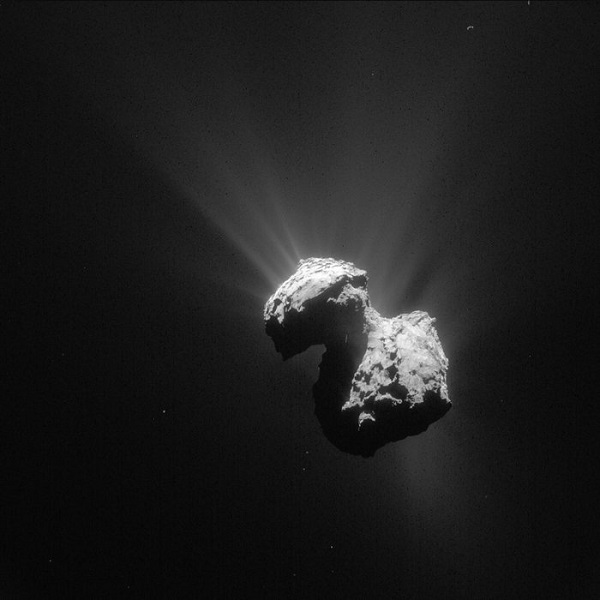When large asteroid 2014 JO25 cruised past Earth on April 19th, Goldstone and Arecibo radars were at the ready.

NASA / JPL-Caltech / GSSR
NASA gave us a new view of a small chunk of solar system real estate, and what a strange yet familiar world it is.
Asteroid 2014 JO25 passed 1.1 million miles (1.8 million kilometers) from Earth on April 19, 2017. That's 4.6 times the distance from Earth to the Moon. This pass was the closest of an asteroid 600 meters or larger from Earth since 3-mile wide 4179 Toutatis passed four lunar distances away from Earth in September 2004. This is also the closest 2014 JO25 has come to Earth over the past 400 years.
The close pass provided a great opportunity for amateur and professional telescopes to image the tiny world as it glided through the night sky. It's a thrilling and rare sight to see the tiny dot of an asteroid slowly moving across the starry background in real time at the eyepiece.

Gianluca Masi / The Virtual Telescope Project
NASA also took advantage of the close pass to ping the tiny world with Goldstone and Arecibo radar, pinning down the future three-year orbit for 2014 JO25 to a high degree of precision — a rare feat among the 16,000 known Near-Earth asteroids. The radar images also peg its rotation rate at 4.5 hours.
Prior to this, observations from NEOWISE had suggested an estimated albedo, or reflectivity, of 25% for 2014 JO25 — about twice as bright as the average surface albedo of the Moon. Based on its albedo, astronomers estimated a diameter of 650 meters.
The radar images instead showed that, while the asteroid is indeed about 600 meters across its short axis, the longest part of 2014 JO25 spans a full kilometer, much larger than expected. Though 2014 JO25 passed Earth at a safe distance and poses no threat to humanity Earth in the foreseeable future, this analysis of the asteroid's size serves as a cautionary tale.
Characterizing Asteroid 2014 JO25
NASA used the SpeX spectrograph on its 3-meter Infrared Telescope Facility (IRTF) based at the Mauna Kea, Hawai'i, to classify the asteroid based on absorption features. The result: 2014 JO25 is an S-type “stony” asteroid, similar to what Japan's Hayabusa saw up close to 25143 Itokawa.
The asteroid's twin-lobed, contact binary appearance proved to be the real surprise. It's a cosmic Rorschach Test: Do you see a flying “space peanut,” or a giant rocky rubber duck? While 2014 JO25 spans about a kilometer on its longest axis, a bifurcation between the two lobes dives 200 meters deep. Moreover, that fast 4.5-hour spin ought to be on the verge of flinging the two lobes apart.

NASA/Arecibo/USRA
Does 2014 JO25 look familiar? The European Space Agency's Rosetta mission just wrapped up its thrilling exploration of 67P/Churyumov-Gerasimenko, a comet four times larger than 2014 JO25 with a strikingly similar "rubber duck" appearance. And Arecibo imaged another twin-lobbed NEO earlier this year: Comet 45P/Honda-Mrkos-Pajdušáková.
"We've known of contact binary near-Earth asteroids (NEAs) for a long time," says Shantanu Naidu (NASA-JPL). Arecibo radar images of 4769 Castalia taken in 1989 revealed the first contact binary shape among NEAs. Since then about 50 contact binary NEAs have been discovered by radar and it is estimated that about 15% of NEAs bigger than 150 meters have a contact binary shape."
All These (Duck-Shaped) Worlds
So why are twin-lobed, near-Earth objects a “thing” in this humorous universe of ours? While these strange worldlets have left planetary scientists scratching their heads, there are a few possible scenarios to consider:
- One is a gentle, low speed collision between two objects — perhaps we're seeing just how planetary accretion might've occurred back in the halcyon days of the solar system's youth.
- Or maybe we're seeing a slow, distended distortion as the asteroid is “spun up” due to what's known as the Yarkovsky-O'Keefe-Radzievskii-Paddack (YORP) effect, as the surface absorbs visible light and re-radiates energy in the infrared.
- A third option is that the asteroid's rubble-pile might have become distorted by an ancient pass near a large planet — 2014 JO25 has passed near both Mercury and Earth.

ESA / Rosetta / NAVCAM
As worlds such as 2014 JO25 change from mere dots of light to real places for exploration, planetary astronomy gives way to planetary geology. Future asteroid missions such as Hayabusa 2 en route to arrive at asteroid 162173 Ryugu in July 2018, NASA's OSIRIS REx currently headed to 101955 Bennu and the Lucy and Psyche missions set to launch in 2021 and 2023 respectively will provide “ground-truthing” for just what worlds such as 2014 JO25 are like, just in case we ever have to attempt to move one out of Earth's way.
 6
6
Comments
Robert-Casey
May 12, 2017 at 10:50 am
If you look at the top picture of this asteroid in cross eye stereoscopic mode, you can see the asteroid in 3D. Adjacent images as it rotated provide views your left eye and your right eye would see if you were a really large person a few kilometers tall, or if the asteroid was only a few centimeters wide and you held it in your hand at arms length.
You must be logged in to post a comment.
Aqua4U
May 12, 2017 at 8:25 pm
Seeing these radar images of yet another lobed or conjoined asteroid knocks my shoes AND socks off! Way cool.. Beside the obvious gravitational attraction, I wonder how much attraction and bonding is due to piezoelectric forces/charges? The 4.5 hour rotation rate is pretty 'zippy' to not be flung apart?
You must be logged in to post a comment.
Azizbek
May 19, 2017 at 12:19 am
Breaking news. Last night 19 may 2017. nearly 12 : 23 a.m. I was observe northern west huge meteor fall approximately Tashkent regoin which near mountain. I don't catch up take video but was fantastic comet when comet crash down periot explod and become small pieces but three or four pieces was enught crash earth. After fly comet 8 - 10 minute three time be heard like detonate a bomb and slowly earthquake about 3 or 2,5 level. Last night earth was passing comet galley orbit .
You must be logged in to post a comment.
David DickinsonPost Author
May 19, 2017 at 9:56 am
Hi Azizbek,
Did a brief bit of research, and you "may" have seen the reentry of the Chinese CZ-7 Rocket Body NORAD ID 2017-021B: http://www.aerospace.org/cords/reentry-predictions/upcoming-reentries-2-2/cz-7-rocket-body/ US JSpOC's Space-Track's prediction jibes well with the time and location of the sighting. I'll mention it to the See-Sat message board and see what they turn up. Let us know if anyone caught it on video.
-Thanks,
Dave Dickinson
You must be logged in to post a comment.
Azizbek
May 19, 2017 at 2:10 am
Why world news don't shaw meteor crash but it was mid night the majority people realy don't saw meteor was swiftly fall but was very bright. I thing that from earth satellite search and take photography approximately fall eastern part of Tashkent region or eastern part of around Uzbekistan. May be NASA science have interest ? they will help us if we cuoldn't found meteor peices. I strongly belive that meteor was make crater.
You must be logged in to post a comment.
Janine Myszka
May 19, 2017 at 9:10 am
You may consider reporting this to the International Meteor Organization - it certainly sounds like a spectacular event!
You must be logged in to post a comment.
You must be logged in to post a comment.